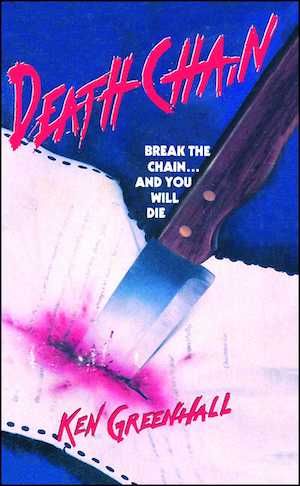
Share This Link 9 Times or Never Read a Good Book Again!
“I’m looking for people to participate in a huge book exchange. You can be anywhere in the world. All you have to do is buy your favorite book (just one) and send it to a stranger (I’ll provide their details through a private message).
You’ll receive a roughly maximum of 36 books back to you, to keep. They’ll be favorite books from strangers around the world.
If you are interested in taking part, please comment ‘IN’ below and I’ll send you all the details.”
You’ve likely seen this message (errors and all), or one like it. Maybe it was in a letter in 2018. Or on Facebook in 2020. Or Instagram in 2022. This sort of book exchange scheme pops up every few years, each promising that you can get about 36 books just by mailing out one. As you’ve probably guessed, it doesn’t usually work out like that. It’s a pyramid scheme: the people who get in early might come out fairly successful, but the majority of people will end up with no books at all. As a Canadian, I find this one particularly distasteful: it costs about $15 just to ship within the country here, so buying a new book and sending it overseas could be about a $50 commitment, which is steep for something that has a good chance of not returning any investment at all.
I’ve been fascinated with chain letters for years, partly because of their staying power. They evolve with every new technology, staying relevant over centuries. We can trace them back almost as far as writing, and I wouldn’t be surprised if oral stories with some “tell five people or be doomed for all eternity” element were told before that.

Chain letters have inspired books and movies, mostly of the murder mystery or horror variety. There’s Chain Letter by YA horror author Christopher Pike — not to mention Chain Letter 2: The Ancient Evil — and Deathchain by Ken Greenhall, whose cover promises, “Break the chain…and you will die.” Claire McNab and Ruby Jean Jensen both have mysteries that share the title “Chain Letter.” A horror movie in 2010 is titled “Chain Mail,” and The Ring — based on the book Ring by Koji Suzuki — is essentially a chain letter in VHS form. Although chain letters can be used for inspiration, charity, or profit, we clearly associate them with their more nefarious variety, which threaten death to anyone who would break the chain.
Chain letters are the original meme. They exist to be passed on, and they often change along the way. But although sharing them can come from a desire for community or optimism about their potential, they can also be dangerous. Chain letters, pyramid schemes, and Ponzi schemes all have the same DNA, and sometimes they are one and the same. It’s perhaps not surprising they saw a surge in popularity during both 2020 and the Great Depression. They offer an illusion of control, which is attractive when you feel powerless.
Let’s take a look back in time to see where chain letters began, and how they keep copying themselves even today, promising luck, money, and even books.
A Brief History of Chain Letters

It’s hard to nail down the first chain letter because it depends on the exact limits of your definition. The Egyptian Book of the Dead promises that anyone who copies the image “shall find it of great benefit to him both in heaven and on earth.” The “man who knows not this picture shall never be able to repulse the serpent Neha-hra.” A medieval version of a chain letter claimed to be authored by Jesus himself: “He that copieth this letter shall be blessed of me. He that does not shall be cursed.”
Of course, for chain letters to really take off, they needed more people to be able to both read and write — and a reliable postal service helped. Snopes puts the first “full-fledged” chain letter in 1888, which was used to raise money for charity. A 17-year-old Red Cross volunteer started a similar letter in 1898 to raise money to buy ice for troops in Cuba, which soon flooded a tiny Babylon, N.Y. post office with thousands of letters, prompting her mother to put out a statement urging people to stop sending money. These early versions were very successful, with a benefiting school proposing it as a long-term fundraising strategy: the “peripatetic contribution box.”
It didn’t take long for these promising money-making strategies to be turned into more selfish motivations. By 1917, a New York Times article accused chain letters of being a German plot to clog the postal service. (It’s charming now to imagine the post office getting too much business as their biggest hurdle.) In 1922, a scathing Saturday Evening Post editorial asked if chain letter participants realize that a completed “chain” would require 3.5 billion people, $70 million in postage, and several forests’ worth of paper. “[T]heir common sense appears to be urgently in need of an injection of either monkey or goat gland,” the author continues.
The height of chain letters’ popularity was in 1935, with the “Send-a-Dime” scheme. This chain letter was so popular that stores selling certificates to prove you were “officially” on the chain popped up in empty storefronts. One had over 100 employees when it was shut down! After a few weeks, the Send-a-Dime chain collapsed: there was no one to send a letter to that wasn’t already in the chain, and the postal service had declared it violated lottery laws. By July, it left “between 2,000,000 and 3,000,000 letters in the dead letter offices” — and those were just the undelivered ones! The popularity of the Send-a-Dime letters spurred spin-offs, like whiskey chain letters, as well as parodies, like a “send a Packard Automobile” letter, which said, “Think how nice it would be to have 15,625 automobiles.”
Click here to continue reading this free article via our subscription publication, The Deep Dive! Weekly staff-written articles are available free of charge, or you can sign up for a paid subscription to get additional content and access to community features.











